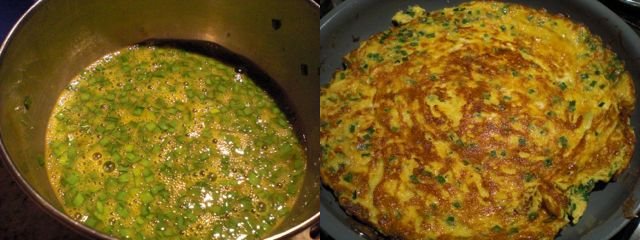Japanese think the combination of garlic chives and eggs is particularly good. This dish, "Nira-tama", "nira" means garlic chives and "tama" is short for "tamago" meaning eggs, is one of these dishes and must have a root in a chinese dish.
Fresh garlic chives (one small bunch) chopped into small pieces. I mixed the pieces into the beaten eggs (2 large) and seasoned with salt and pepper (left). In a small no-stick frying pan, I added vegetable oil and sesame oil (1:1 total of about 3 tsp) and cooked it on medum low flame for a few minutes and flipped over (right)

For the sauce, I simply mixed dashi (1/4 cup), soy sauce (1 tbs) and mirin (1 tbs). When it came to a boil, I added a potato starch slurry made with sake (2 tsp) to thicken the sauce. You could add vinegar to make it a sweet and sour sauce or add hot sauce to make it spicy.
I served this as a drinkng snack. This late spring/early summer garlic chives were tender but did not have a strong flavor--it was a classic taste of the season. I served this with asazuke of cucumber, daikon and carrot, blanched broccolini with mustard soy sauce dressing or "Karashi souyu" 芥子醤油.
I served this as a drinkng snack. This late spring/early summer garlic chives were tender but did not have a strong flavor--it was a classic taste of the season. I served this with asazuke of cucumber, daikon and carrot, blanched broccolini with mustard soy sauce dressing or "Karashi souyu" 芥子醤油.

No comments:
Post a Comment
When you post a comment on the post, it does not appear immediately pending moderation.